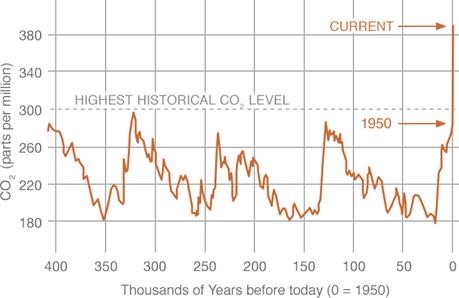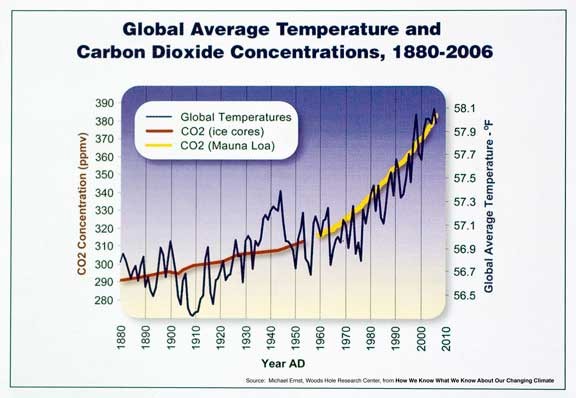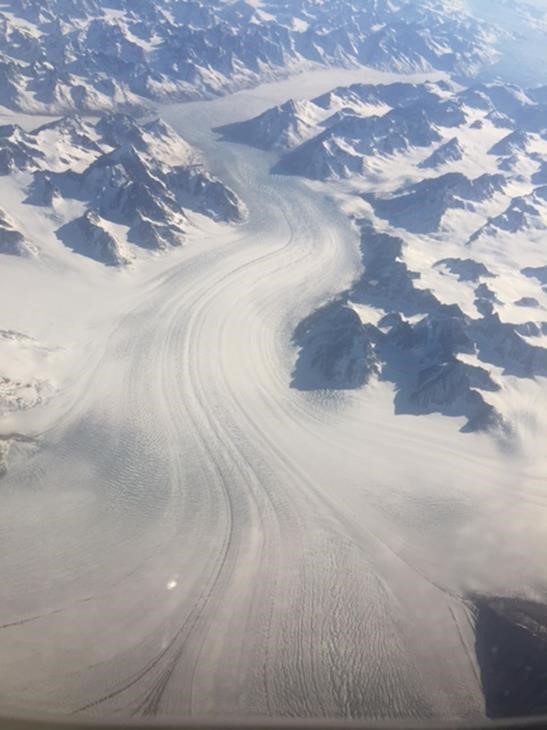The Carbon Trifecta: A Global Warming Solution
by Mark Anderson, founder of the Carbon Trifecta and CEO of Strategic News Service
The world has a big problem. Well, actually, it has several.
The greatest problem the planet faces today is global warming. And the greatest problem that humans face is their general inability to act together until just after a crisis hits.
America’s behavior at the onset of World War II would be a good example. Understandably reluctant to get re-involved in Europe’s self-destructive patterns of war, we ignored history’s recent lessons and waited too long, while many of our industrialists secretly made money by helping Hitler – and British PM Neville Chamberlain famously chose appeasement over facing the truth.
I chose this example because at FiRe 2011, our Future in Review CTO Design Challenge team decided that the solution to global warming would have to include real leadership, as the planet faced yet another “Churchillian moment.” More specifically, they found that:
- Every year wasted in starting a real response would result in many years of harm later;
- The response would have to be in phases, rather than a single immediate answer; and
- It was still (at that time) possible to avoid the massive economic, biological, and human “climate refugee” dislocations of a 2-degree Centigrade global temperature increase.
In other words, the problem of global warming could indeed be solved, if we had real leadership on the issue.
Surveys suggest that a strong majority of people today agree that global warming is a reality, that it is human-caused, and that it needs serious attention. Its prioritization among US voters, for example, has climbed over the last decade or so from near-last to near-first. Given the recent Paris Accord, it’s also clear that global political leaders today at least pay lip service to solving the problem.
And yet there remains an almost palpable sense of hopelessness. With so much decisive science now in, there is no obvious excuse except to suggest that this behavior is driven by willful ignorance (i.e., greed, and/or fear of change). One imagines a lifeboat filling with water, sharks circling, with two survivors playing high-stakes poker. When their mate suggests bailing water before it’s too late, one retorts, “Not now – I’m too busy making money.”
Here’s a NOAA chart of long-term atmospheric CO2 levels:

And another showing the well-documented correlation between atmospheric CO2 and global warming:

One of the greatest risk factors today may be the Mad Magazine attitude of “What, me worry?” among the population, a normal reaction to “boiling the frog,” or to slow or non- linear change. Humans do well with earthquake disasters – but not well at all with long- term, non-linear threats.
In this sense, even the charts can be misleading; after all, one might presume, whether it’s a little warming (good for crops in the north) or a little sea-level rise (won’t affect Kansas), who really cares? Let’s get on with making money –
What’s missed in this attitude (other than crop devastation and coastal destruction) is the certainty of higher-order non-linear change that warming has brought and will continue to bring at an ever-more-rapid pace.
Unexpected, Non-linear Threats
Examples of unexpected, non-linear threats would include huge die-offs of plants and animals, caused by heat stress in traditional habitats and augmented by new bacterial blooms or pest population explosions. The devastation of nearly the entire starfish population along the US West Coast, now known to have been caused by water temperature increase and an accompanying bacterial infection, is indicative of how trouble in food chains can cause the sudden destruction of ecosystems.
The ongoing loss of Pacific Northwest fir forests to the mountain pine beetle is another. There are many more, including but not limited to such enablers and events as:
- Albido (solar absorption) change in polar waters: the more ice floes melt, the warmer the water gets, the more ice floes melt;
- Dynamics of the Greenland ice sheet melting: the more onshore ice melts, the more under-ice rivers flow, the faster the ice melts;
- Dynamics of particulate soot on Greenland: the more soot from Asian pollution falling on Greenland ice, the more ice melting (see above);
- Ocean acidification: the more acidic the ocean, the less life it will contain, including phytoplankton; the less phytoplankton, the less CO2 absorption, which leads to more warming and acidification;
And so on.
At our recent FiRe Meeting of the Minds planning session, several advisory board members pointed out the unexpectedly rapid destruction of coral reefs, from Australia’s Great Barrier reef (now, suddenly, 93% bleached or dying) to the sudden global coral reef loss of perhaps 50%. Here’s a picture of what global warming, including warmer sea temperatures and increased ocean acidity, has done, when linked to a record “El Nino” event:
Damaged and Dying Coral Reefs

Source: NOAA
Color Coding:
- Yellow: Warning
- Orange: Coral Bleaching Likely
- Dark Red: Coral Mortality Likely
After a long run-up to this tragedy, most of the damage has occurred over the last two years or so.
Two years.
These are the kinds of non-linear events that will become commonplace in general, yet are unexpected in the particular, as we move forward up the global warming curve.
The ice
For those who insist on making money while the lifeboat sinks, there is always the polar ice as a way of avoiding controversy. There are two aspects to this problem, and two poles to look at: basically, Greenland and Antarctica.
First, as noted above, non-linear effects have proven all Intergovernmental Panel on Climate Change (IPCC) projections of ice loss to be too conservative – meaning, too low. The faster the ice melts, the faster the ice melts, with current estimates showing huge increases in expected icemelt on both poles and very large jumps in sea-level rise estimates.
Here is one picture of what Greenland looks like today, from a flyover I did last week, showing the massive and accelerated flow of ice into the sea:

Of course, this is just a single photo, but backed by what we now know about revised estimates for icemelt, it is truly chilling.
From an email I received last week by another of our advisory board members:
“… [A] couple of weeks ago in Boston [as you emailed me] I was leading a session for an engineering design firm, a firm that concentrates on eastern seaboard cities. One of the external SME’s was Dr. Hans-Peter Plag, of Old Dominion in Norfolk. He blew me away, which is not easy to do. He fairly recently was on a commission in the Netherlands on whether to build the sea protections even more robustly. He made news by being the lone dissenter, saying sea level rise is game over, stop building dikes and prepare the nation to move inland. Quite a radical view. I’d love to interview him on stage at the next FiRe, if Sea Level Rise is on the agenda —” [Emphasis ours]
Moving cities inland entails a cost beyond my understanding, but so does losing coastal real estate. The fact that an expert from the Low Countries is suggesting that we just abandon the fight against rising sea levels is perhaps a harbinger of things to come.
We know that the world’s great cities, and most expensive real estate, are on the coasts. But what is the financial cost of losing it? Whatever the number, I have no doubt it is beyond the ability of any country to afford. Who is ready to pay for the replacement costs of LA, New York, San Francisco, Shanghai (Beijing will also be underwater), Hong Kong — ?
From a paper published in Nature last week, documenting a doubling of the expected sea-level rise, to at least 3 feet by century’s end:
“The Antarctic retreat could happen much faster and much more than we previously thought,” said David Pollard, one of the lead authors and a researcher at Pennsylvania State University. “This is just the Antarctic contribution to future sea-level rise, but if there’s anything to this, and if we really follow the business- as-usual [emissions] scenarios, then this contribution would exceed all other contributions over next years.”
And a description of this research report from Scientific American:
The researchers stressed that a range of scenarios exist, based on how quickly the world cuts back on greenhouse gas emissions from burning fossil fuels. If emissions were rapidly decreased, Antarctica would cause sea levels to rise less than a foot by 2500.
In the worst-case scenario, sea levels could rise around 50 feet by 2500. Even in a moderate scenario in which emissions stop after 2500, the long “thermal memory” of the ocean would prevent the ice sheet from growing back for centuries.
And this brings us back to the FiRe CTO Challenge of 2011: our panel was clear in stating that reducing emissions of CO2 now, not later, was critical in avoiding catastrophe. Looks like they were right.
As we’ve mentioned before, just-re-elected Florida Governor Rick Scott was recently discovered to have put into place (through a now-retired head of the Department of Environmental Protection) an unwritten regulation against any state employee using the term “global warming.” Wow. That’s both self-delusional and self-destructive. But even more important: after half his state is gone (which it will be), how will he be viewed by his grandchildren, or by history? The guy who went on with his poker game while the lifeboat sank.
Here’s the Miami Herald (March 18, 2015):
“We were told not to use the terms ‘climate change,’ ‘global warming’ or ‘sustainability,'” said Christopher Byrd, an attorney with the DEP’s Office of General Counsel in Tallahassee from 2008 to 2013. “That message was communicated to me and my colleagues by our superiors in the Office of General Counsel.”
Kristina Trotta, another former DEP employee who worked in Miami, said her supervisor told her not to use the terms “climate change” and “global warming” in a 2014 staff meeting. “We were told that we were not allowed to discuss anything that was not a true fact,” she said.
This unwritten policy went into effect after Gov. Rick Scott took office in 2011 and appointed Herschel Vinyard Jr. as the DEP’s director, according to former DEP employees. Gov. Scott, who won a second term in November, has repeatedly said he is not convinced that climate change is caused by human activity, despite scientific evidence to the contrary.
So, not only is the problem one of planetary scale, and increasingly
clear threat, but it’s also politically still a “hot potato,” at least
in the retrograde US. In fact, as Americans know, although a clear
majority of Republican party members recently surveyed agree that global
warming is a major issue, and is caused by human beings, not a single
GOP candidate for president has been “allowed” to say so.
I don’t care which party wins the US presidency, but I do care about destroying the planet. At speeches recently, I’ve taken the position that “no person should be allowed near the White House who does not recognize the importance of addressing global warming.” While my audiences are almost always majority Republican, they have uniformly responded with spontaneous applause for this suggestion.
Solving Simultaneous Equations
If we stand back and ask what needs to be done in order to find a safer path through these landmines, we can identify three major problems facing the world, all of which need solving:
- Human-caused emissions of CO2 and methane are accelerating global warming;
- Our global materials plan is currently based on serial resource exhaustion, and so is not sustainable over time or increased headcount;
- Current manufacturing technology is suited to the above CO2 production and resource exhaustion; we need to develop new commercial demand and business solutions for making the planet’s things without destroying it.
In addition, there are a few other related challenges, which can also be considered “simultaneous equation” contributors. These include:
- Greenhouse gas emissions need to be curtailed immediately, and not on some distant promised future date safely beyond current profits;
- Corporate control of government has led to gridlock, preventing rational discussion and decision-making on this issue – therefore, resolution needs to satisfy business as well as political demands;
- Almost all decision-makers are operating on a short-term cycle (political re- election, CEO quarterly compensation), also preventing intelligent long-term planning;
- 3D printing, an alternative manufacturing process, remains a hobby, limited by a small number of jets, vs. the large number of materials in most objects.
Is there a solution set that satisfies all of these requirements? Of course, or you wouldn’t be reading this.
The Carbon Trifecta
Over the last eight years, we have been working with a combination of leaders in technology, manufacturing, academia, and government to refine a proposal that would prevent planetary disaster while satisfying the requirements described above. As it has evolved, we have shared these ideas with the White House, the Department of Energy, the Graphene Stakeholders Association, participants at our FiRe conferences, SNS members, the SNS FiRe / Park City Institute Speaker Series, Forbes, and elsewhere.
Now, we are launching it as the latest SNS Global Initiative. To start with, let’s make this simple:
We need to take all of the CO2 out of smokestacks immediately. This is the Churchillian Moment issue: all companies, and all nations, need to stop emitting CO2 now. In reality, one could imagine a global agreement to stop emissions within, say, three years.
Since coal and gas plants have long-term cycle lives, returns on investment, owners, and users, we need a new approach. How can we turn CO2 from a waste product into a commercial good, and in so doing turn political opponents wasting time into business partners making money?
Today, there are an increasing number of companies working on the CO2 problem. Just burying CO2 seems doomed as a solution: it is a huge cost, with no return. Turning CO2 into biofuels seems outdated, insofar as re-burning the carbon puts CO2 back into the atmosphere.
But what if we could turn CO2 into the most valuable chemical on the planet? Well, what is that? It’s graphene. And there is a company that we found – Graphene Technologies Inc. – which had anticipated this exact problem and has a patented system for catalyzing this reaction. In other words, this company’s process uses less energy than otherwise to reduce carbon into a single-atom-thick sheet (or platelets).
Making money from waste is smart, and it aligns the interests of corporate owners, politicians, and environmentalists. Mission accomplished.
But this is only true if there is a market. What is graphene good for? While the EU spends $1B on graphene commercialization, and the UK another $500MM, finding answers that are as numerous as they are diverse, we need an answer on a planetary scale. What could consume enough CO2 to make a difference?
That would require mass manufacturing of most of the things we see around us today, from construction to tennis rackets, from clothing to glass, from cars to planes, chips to computers. Well, graphene can be all of these things. But how would that manufacture happen?
3D printers are uniquely positioned to do exactly that. Already, companies like LocalMotors are doing prep printing in plastic of entire cars. Why not print the wires, glass, and everything else in one pass? With graphene, it’s possible. Not today, not tomorrow, but perhaps within a few years.
By solving all of these simultaneous equations – simultaneously – it’s possible to solve all of the problems contained within the global warming challenge, satisfy all parties, and achieve everyone’s goals.
Jon Myers, the CEO of GTI when we first met, is now an active member in this SNS initiative. After all, his catalysis reaction may be a key to making it all work. I asked Jon to create a document to share at our meeting with one of the national laboratories last week, which he was kind enough to do.
Summary
We are now on the cusp of building scientific, corporate, and political momentum behind a proposal that we think can actually avoid climate catastrophes, preventing temperature excursions from which it would be difficult to recover.
At stake are not only the financial and security futures of our grandchildren, cultures, and countries, but also the survival of a large fraction of the plant and animal species alive today. With widespread and rapid support for the Carbon Trifecta, there is no reason we can’t look forward to a future that we all prefer.
There is room at this proprietary and open-source table for every university, company, and country. In fact, without such wide-scale international cooperation, the plan won’t work. Rich countries and poor; China and the US; the EU, UK, and Australia; companies in technology and finance, utilities and chemicals; universities, think tanks, governments, laboratories, and individuals, can all be productive parts of this new program.
This article first appeared in Strategic News Service newsletter on May 19, 2016.
About Mark Anderson
 Mark Anderson is Founder of the Carbon Trifecta. He is CEO of Strategic News Service (SNS) and publisher of the weekly SNS Global Report on technology and the global economy, read by Bill Gates, Elon Musk, Vint Cerf, Michael Dell, Paul Allen, Craig Venter, Jeff Bezos, Bill Janeway, Paul Jacobs, Leroy Hood, and technology executives and investors worldwide. He is a member of the Graphene Stakeholders Advisory Board. He is CEO of SNS Conference Corp. and chairman of the Future in Review (FiRe) conference – now in its 14th year – which the Economist has named “the best technology conference in the world.”
Mark Anderson is Founder of the Carbon Trifecta. He is CEO of Strategic News Service (SNS) and publisher of the weekly SNS Global Report on technology and the global economy, read by Bill Gates, Elon Musk, Vint Cerf, Michael Dell, Paul Allen, Craig Venter, Jeff Bezos, Bill Janeway, Paul Jacobs, Leroy Hood, and technology executives and investors worldwide. He is a member of the Graphene Stakeholders Advisory Board. He is CEO of SNS Conference Corp. and chairman of the Future in Review (FiRe) conference – now in its 14th year – which the Economist has named “the best technology conference in the world.”
Articles on the Carbon Trifecta
The Carbon Trifecta: A Global Warming Solution
White Paper: Graphene Production from Carbon Dioxide
